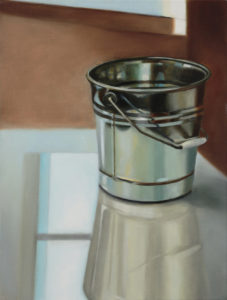 Bucket & Reflection
Bucket & Reflection
Cally Lotz
2018
Oil on linen
41 cm x 31 cm
The oil painting “Bucket & Reflection” by the Australian painter Cally Lotz shows, as the title indicates, a bucket with reflections. Depicted in a photorealistic manner, the artist placed the metal pail at the right picture half, on a bright support. This surface reflects the object and also the light incidence through a window, which should be located somewhere at an invisible wall behind. The farer background is blurred, but it seems to be a room with a brown floor and a skirting board. Its materiality remains ambiguous, due to the vague painting style: by the colour, it could be timber; by the brushstroke, it also could be a carpet. Likewise, the identification of the bucket carrying area is difficult: it might be a piece of the floor that differs from the one in the background or even a table with a glossy surface. This ambiguity stands in stark contrast to the clear depicted bucket and highlights the object in its importance. Similarly, works the line management: the two boundary-lines of the bright support and a vertical line, which limits a darker brown colour field right hand of the pail, meet somewhere behind the focussed object. Moreover, the assumed skirting board in the background, ends somewhere above the bucket to highlight it with a bright colour field. If there weren’t the reflections of the bucket and the window in the foreground, the composition would get out of balance.
An initially photorealistic assumed painting turns out to be a strongly conceived arrangement. Even the pail itself has no hard shapes, so that it is far to look like a collage. The metal reflects the environment with its colours, which let it partly merge to the back- and foreground. In addition, the highlights and shadows seem to be a little bit exaggerated. All these elements, guide to a classification more in the direction of hyperrealism than photorealism. Traditional photorealist paintings of the late 20th century have a literal approach by a direct imitation of a photograph. Whereas hyperrealists compose – although often originating from photographs – a more detailed, tangible rendering. It is more the illusion of a reality.
Furthermore, “Bucket & Reflection” is to be classified as still life. This is a much older genre, originating even from antiquity with its high time in the Dutch Golden Age. Particularly classical are still life’s with flowers, fruits, meals, instruments and the vanitas. Over time, the topics became, like in other genres, less bourgeois. Profane elements as working devices were introduced. Even the arrangements got less glamorous. In the period of modern art, artists introduced new techniques and forms of composition. Latest with pop art, everyday objects like Andy Warhols “Tomato soups” were on focus.
However, Cally’s bucket is not so much an everyday object in the sense of consuming as it is for Warhol. It is an object, made by humans for daily use. With this, the artist goes more in the direction of Giorgio Morandi, who depicted bottles, vases, mugs and bowls, which are related to human activities and requirements. These objects are witnesses in the sense of Martin Heidegger and refer to the “Dasein” (~ being). They illustrate the human existence in time, because we use them to make a living. This leads us close to the term “still life”. It originates from the Dutch “stil leven” (stil = motionless; leven = being), first used for a painting around 1650 in a Dutch inventory.
The artist herself describes her process of painting and the outcome as meditative. She doesn’t emphasise the physical aspect of the objects themselves. “There is no conscious intention of implying deeper symbolic meaning, but more of cultivating an awareness of the enigma that things exist.”
Cally Lotz
Born in Melbourne, Australia, Cally Lotz grew up in Zimbabwe. After attending Bath Academy of Art, Great Britain, she obtained a bachelor of Visual Arts (hons) from the University of South Africa in 2009. Following this, she completed a Professional Practice in the Visual Arts at Artspace/Art Source in Pretoria, South Africa. Currently, she is studying a Master’s degree in Fine Art at RMIT (Royal Melbourne Institute of Technology).
Since 2006, Cally has participated in many group exhibitions, mainly in South Africa and Australia, but also in Germany, India and France. Moreover, she has had several solo exhibitions in Australia and South Africa and curated a group show at the Tatham Gallery, Pietermaritzburg, South Africa.
In 2018, the artist was a finalist at the Eutick Memorial Still Life Award (EMSLA), Australia and has been selected several times for diverse awards. For the period 2014/15 she was granted a year’s residency at St. Vincent’s, Melbourne. Her most recent residency was in 2017 in France at A.I.R. Vallauris.
Cally paints still life’s of everyday objects in a realist/expressionist manner. The background is often only a plan or a blurry space, whereas the items are mostly realistically represented. Nevertheless, there are rarely traces of usage and reflections are strongly highlighted. Depicted are keys, containers, wrapping papers and foils or – like our artwork of the month January 2019 – buckets. In her work, the artist’s attention is not focussed on the physical aspects of the objects, but more a reflection on their existence. Beyond that, many of her items can be used to hold or enclose something. Here her consideration is interiority and the literal or metaphorical possibility that the objects contain something that enable further perception.
Cally lives and works in Melbourne.
